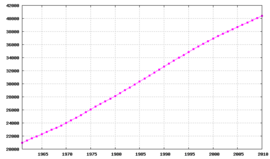Demographics of Argentina

Population of Argentina, 1961–2010
|
|
| Population | 42,192,500 |
|---|---|
| Growth rate | 1.036% (2010 est.) |
| Birth rate | 17.75 births/1,000 population (2010 est.) |
| Death rate | 7.39 deaths/1,000 population (July 2010 est.) |
| Life expectancy | 77.14 years |
| • male | 73.9 years |
| • female | 80.54 years (2012 est.) |
| Fertility rate | 2.29 children born/woman (2012 est.) |
| Infant mortality rate | 10.52 deaths/1,000 live births |
| Net migration rate | 0 migrant(s)/1,000 population (2012 est.) |
| 0–14 years | 25.2% (male 5,450,679/ female 5,200,704) |
| 15–64 years | 63.6% (male 13,400,997/ female 13,440,948) |
| 65 and over | 11.1% (male 1,940,810/ female 2,758,356) (2012 est.) |
| Total | 0.97 male(s)/female (2011 est.) |
| At birth | 1.05 male(s)/female |
| Under 15 | 1.05 male(s)/female |
| 15–64 years | 1 male(s)/female |
| 65 and over | 0.7 male(s)/female |
| Nationality | Argentine |
| Official | Spanish language |
| Spoken | English, Italian, German, Welsh, Yiddish, Portuguese, Guarani, Quechua, Mapudungun and many others are also spoken varying by region |
This article is about the demographic features of Argentina, including population density, ethnicity, economic status and other aspects of the population.
In the 2001 census [INDEC], Argentina had a population of 36,260,130 inhabitants, and preliminary results from the 2010 census [INDEC] census were of 40,091,359 inhabitants. Argentina ranks third in South America in total population and 33rd globally. Population density is of 15 persons per square kilometer of land area, well below the world average of 50 persons. The population growth rate in 2008 was estimated to be 0.92% annually, with a birth rate of 16.32 live births per 1,000 inhabitants and a mortality rate of 7.54 deaths per 1,000 inhabitants.
The proportion of people under 15, at 24.6%, is somewhat below the world average (28%), and the cohort of people 65 and older is relatively high, at 10.8%. The percentage of senior citizens in Argentina has long been second only to Uruguay in Latin America and well above the world average, which is currently 7%.
Argentina's population has long had one of Latin America's lowest birth rates and population growth rates (recently, about 1% a year), but it enjoys a comparatively low infant mortality rate. The median age is approximately 30 years and life expectancy at birth is of 76 years. According to an official cultural consumption survey conducted in 2006, 42.3% of Argentines speak English (though only 15.4% of those claimed to have a high level of English comprehension), 8.3% speak Portuguese and 6.9% speak Italian.
Ethnic groups in Argentina
According to the 2010 revision of the World Population Prospects the total population was 40,412,000 in 2010, compared to only 17,150,000 in 1950. The proportion of children below the age of 15 in 2010 was 24.9%, 64.5% was between 15 and 65 years of age, while 10.6% was 65 years or older .
...
Wikipedia
